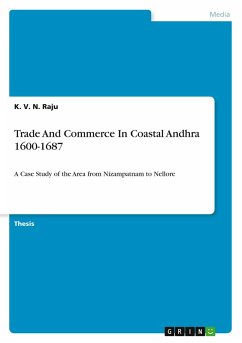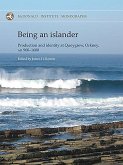Thesis from the year 1999 in the subject Art - History of Art, grade: 9, University of Hyderabad (central university), course: Ph.D., language: English, abstract: From early times the trade and commerce has occupied a prominent place among those economic activities of men which have had comprehensive influence on the history of mankind. Right from the Indus Valley Civilization trade was one of the great up builders of the economic well being of our country. Trading with distant countries was a usual feature of Indian economic life. The advancement of trade and commerce always depends upon certain conditions like the geographical setting, the nature and volume of merchandise, the enterprising trading community, the location of ports, transport, the attitude of state and the availability of hinterland to correspond to all those necessaries required for good going of commerce in the country. India has always attracted traders from various countries of the world for the specificity of our commodities and the hospitality that Indian rulers extended to foreign merchants. During the period of seventeenth century Coromandel Coast, of which Nizampatnam and Nellore were integral parts, assumed importance because of the major trading activity; it gained importance because of two reasons (a) It exported large volume of goods to various countries of the world. It was bestowed with large hinterland to supplement it's demand. Coromandel Coast varied from time to time during 17th century. The activity of trade and commerce in the coastal Andhra region has long history, it can be traced back to Satavahanas and in later times Pallavas and Cholas. The important ports at that time were such as Kanchi, Kaveripatnam and Masulipatnam. It was under the Kakatiya rulers that the development of the ports of Motupalli, Machilipatnam, Krishnapatnam and Hamsaladeevi as centres of trade and commerce gained importance. Subsequently the Muslim invasions and the fall of Warangal in the early fourteenth Century marked the decline of seaborne trade in Andhra. However, after the reestablishment of regional chieftains like Reddy rulers who renovated the port of Motupalli and gave concessions to the merchants to develop the trading activities in the region. The number of ports which grew in Andhra were Ganjam, Kalingapatnam, Bimlipatnam, Visakhapatnam, Kakinada, Coringa, Ingeram, Madapollam, Narasapur, Machilipatnam, Nizampatnam and Aramagaon. All these played an important role in the maritime history of Coastal Andhra region in the seventeenth century. It is because of their economic significance that the Qutb Shahis, the Mughals, the Portuguese.
Hinweis: Dieser Artikel kann nur an eine deutsche Lieferadresse ausgeliefert werden.
Hinweis: Dieser Artikel kann nur an eine deutsche Lieferadresse ausgeliefert werden.








